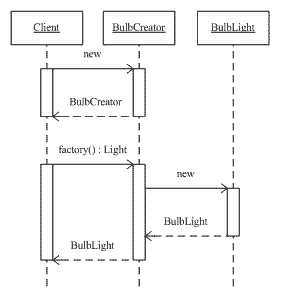The Factor Method pattern lets a class developer define the interface for creating an object while retaining control of which class to instantiate, see pic:
 To summarize, the signs that Factory Method is at work are that an operation:
To summarize, the signs that Factory Method is at work are that an operation:
 and sequence diagram:
and sequence diagram:

 To summarize, the signs that Factory Method is at work are that an operation:
To summarize, the signs that Factory Method is at work are that an operation:
- Creates a new object
- Returns a type that is an abstract calss or an interface
- The class/interface returned is implemented by several classes (The subclass is to determine which class to instantiate)
 and sequence diagram:
and sequence diagram:
